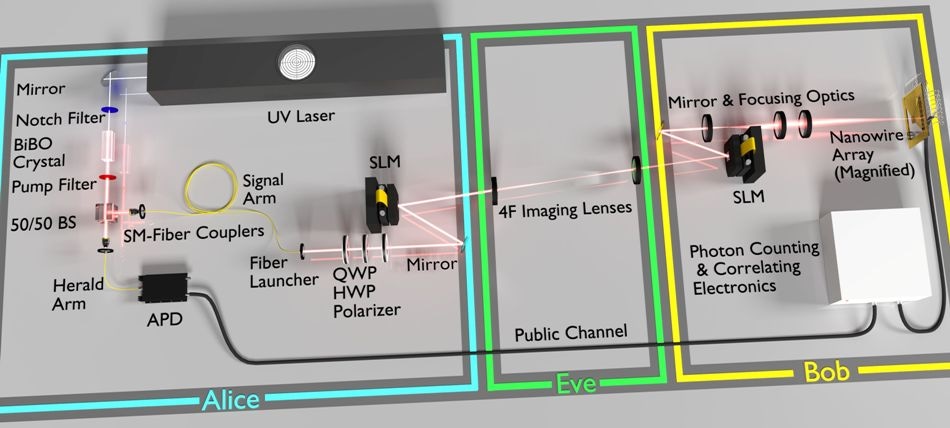Sep 7 2016
University of Rochester researchers have for the very first time demonstrated the possibility of sending an unbreakable encrypted message with a key that is extremely shorter than the message.
 The quantum enigma machine developed by researchers at the University of Rochester, MIT, and the National Institute of Standards and Technology. (Image by Daniel Lum/University of Rochester)
The quantum enigma machine developed by researchers at the University of Rochester, MIT, and the National Institute of Standards and Technology. (Image by Daniel Lum/University of Rochester)
Unbreakable encrypted messages are generally transmitted through a system envisioned by American mathematician Claude Shannon, who is considered to be the “father of information theory.” Shannon combined his knowledge of electrical circuitry and algebra in order to develop a binary system of transmitting messages that are protected, under three conditions: the key is used only once, the key is random, and the key is almost as long as the message.
The journal Physical Review A features the findings by Daniel Lum, a graduate student in physics, and John Howell, a professor of physics.
Daniel’s research amounts to an important step forward, not just for encryption, but for the field of quantum data locking.
Howell
Seth Lloyd, a professor of quantum information at Massachusetts Institute of Technology, developed “quantum data locking”, which is an encryption method that uses photons, the tiniest particles linked with light, to transmit a message. This quantum data locking method was believed to have limitations for encrypting messages in a secured manner, but Lloyd discovered how to make extra assumptions, such as those dealing with the boundary existing between light and matter, in order to make it a more secured method for transmitting data. A binary system permits only on or off position with every single piece of information, while photon waves can be adjusted in several ways: the size of the amplitude can be altered, the wavelength can be made shorter or longer, and the angle of tilt can be modified. The quantum key for deciphering and encrypting a message becomes shorter than the message itself as several variables are present in a photon, thus highlighting the presence of basic uncertainties in the case of quantum measurements.
Till this year, Lloyd’s system continued to be theoretical until the time when Lum and his team came up with a device known as quantum enigma machine capable of placing the theory into practice. This device obtains its names from the encryption machine used by Germany during World War II, which used a coding method that the Polish and British intelligence agencies were able to crack in a secretive manner.
For example, Alice wants to send an encrypted message to Bob. She uses the machine to generate photons that travel via free space and into a spatial light modulator (SLM) that modifies the properties of the individual photons (e.g. tilt, amplitude) to correctly encode the message into flat, tilted wavefronts that can be focused to novel points dictated by the tilt. The SLM is known for altering the shapes of the photons into random designs, which prevent the wavefront from being flat, thus no longer comprising a well-defined focus. Bob and Alice are aware of the keys that detect the implemented scrambling operations, and hence Bob is able to use his own SLM for flattening the wavefront, re-focusing the photons, and translating the modified properties into the distinct elements of the message.
Lum and the team, besides altering the shape of the photons, also used the uncertainty principle, which highlights that the more one is aware of a particular property of a particle, the less the individual actually knows about another of its properties. Due to this, the team succeeded in securely locking in six bits of classical information using just a single bit of an encryption key, an operation known as data locking.
While our device is not 100 percent secure, due to photon loss. It does show that data locking in message encryption is far more than a theory.
Lum
The main goal of the quantum enigma machine is to avoid a third party, for example, an individual called Eve, from interrupting and deciphering the message. A significant principle of quantum theory is that the very act of measuring a quantum system modifies the system. As a result of this, Eve has just one shot in achieving and translating the encrypted message, something that is practically impossible, given the almost limitless number of patterns that survive for every single photon.
The paper by Lum and Howell was one of two papers simultaneously published on the similar topic. The other paper, “Quantum data locking,” was presented by a team headed by Chinese physicist Jian-Wei Pan.
It’s highly unlikely that our free-space implementation will be useful through atmospheric conditions. Instead, we have identified the use of optic fiber as a more practical route for data locking, a path Pan’s group actually started with. Regardless, the field is still in its infancy with a great deal more research needed.
Lum